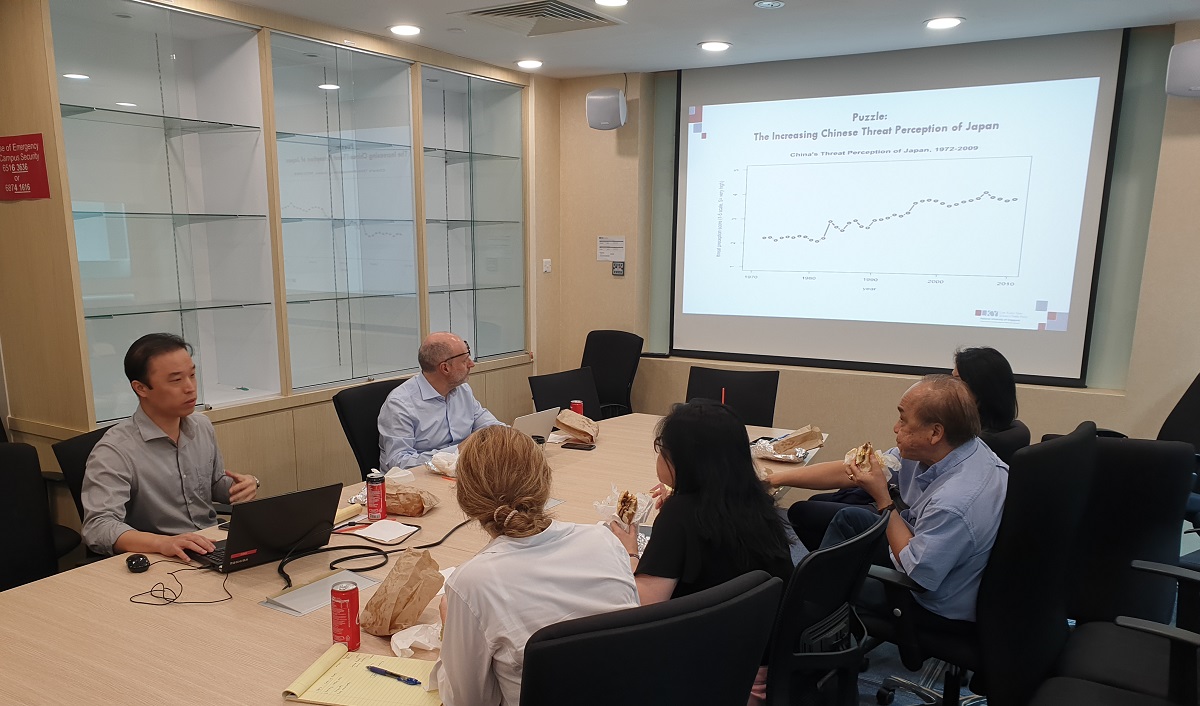
On April 16, Assistant Professor Ryu Yongwook presented in the 21st Politics and IR Brown Bag on the topic of The Increasing Chinese Threat Perception of Japan. The question is that, while Japanese threat perception of China has been increasing since the 1970s, but why is the Chinese threat perception of Japan has also been increasing over the same period of time despite the fact that China’s material strength has caught up with Japan.
Dr. Ryu first pointed out that while there are existing theories that could explain such a trend on part of China, but he argues that these theories, namely, realist theory, realistic conflict theory, balance of threat theory, as well as identity-based theory, all have their limitations in explaining the trend seen in China’s threat perception of Japan. Dr. Ryu agrees that aggressive intentions matter for threat perception, along with power disparity, and inferring the other’s offensive intentions is the key in determining threat perception. The inferences of the other’s intentions reflect deep-seated views of ingroup virtues and outgroup vices. Hence threat narratives are typically bound up with stories of morality and justice. How the other remembers important past military conflict against me is an important variable in inferring the other’s future aggressive/offensive intentions against me
By applying the above-mentioned theory to China-Japan relations, Dr. Ryu argues that the salience of historical memories regarding Japan’s past aggression and colonialism in China invokes deep-seated views of Japanese vices among the Chinese. This therefore leads to reassessment of Japan’s aggressive (or offensive) intentions toward China and increases the Chinese threat perception of Japan. Dr. Ryu believes that threat perception is often not unilateral and arises in a mutually constitutive manner. According to him, the judgment of intention is more useful for a country to decide whether to have a high or low threat perception of another country. Also, he argues that threat perception is mutual, as both countries may have a high threat perception of each other at the same time.
During the Q&A, it has been suggested that instead of just using People’s Daily for preliminary evidences, the PLA Daily can also be used for analysis. Also, it has been pointed out by the audience that while China has stronger hard power as compared to Japan, but it is still worried about the might of Japan due to the latter’s very strong soft power. The strong soft of Japan could be very advantageous for the shaping of world opinion in favor of Japan against China, and it would also influence the Chinese general public, which might in turn challenge the legitimacy of the Chinese government. This is also a reason why China still highly perceives Japan as a threat. Also, if the perceptions of intention and historical memories are driving the changing levels of threat perception, then the project must zero in to specific time periods.
In the case of China, Dr. Ryu said that due to the historical issues between China and Japan, Chinese newspapers are asking if Japan is trustworthy after all. When such rhetoric is been made, emotionality would kick into the minds of the Chinese public, and they would recall of past Japanese atrocities and have a higher level of threat perception against Japan. However, what he finds puzzling is that, while China is taking a tougher stance against Japan on issues such as the dispute at Diaoyu Islands, Chinese perception of Japanese threat still increased since it was China that first took assertive actions. Regarding this puzzle, some members of the audience pointed out that China perceives a higher threat from Japan after challenging Japan could be due to the fact that China believed that Japan would seek US in confronting China. Another reason is that, China “challenges” to Japan were just reactions to Japanese actions such as Japanese denial to the Rape of Nanking and the visitation of Yasukuni Shrine by Japanese prime ministers. This could also be a reason why positive Chinese view towards Japan has been going downhill since the 1980s.
It might be the case that Chinese threat perception against Japan increased when China took more assertive stances towards Japan because China knew that by taking a more assertive stance, it might also receive more retaliation from Japan and its allies, such as the US. This could be one argument that could be further studied. Still, if this is the case, then why did China even take assertive actions against Japan in the first place?
While it has been pointed out that one aspect of the legitimacy of the CCP is based on its anti-Japanese, anti-colonialism nationalism, therefore the CCP would make use of anti-Japanese sentiments to consolidate its domestic rule; but Dr. Ryu noted that in the anti-Japanese museums in China, the focus is more on how the CCP defeated the Japanese invaders rather than inciting hate towards Japan. Hence this in fact deviates from the argument that anti-Japanese rhetoric of the Chinese government causes threat perception against Japan to rise in China. It also has been suggested that if China really sees Japan as a threat to its security, then it would call for an anti-Japanese coalition with other like-minded countries such as North Korea and Russia. If not, then it probably means that China is not taking Japan as a real threat, but just using anti-Japanese rhetoric as a tool for the rallying of its people.